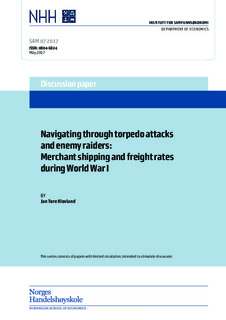| dc.contributor.author | Klovland, Jan Tore | |
| dc.date.accessioned | 2017-06-02T08:14:28Z | |
| dc.date.available | 2017-06-02T08:14:28Z | |
| dc.date.issued | 2017 | |
| dc.identifier.issn | 0804-6824 | |
| dc.identifier.uri | http://hdl.handle.net/11250/2444206 | |
| dc.description.abstract | During World War I ocean freight rates rose to extraordinary levels. Using a new monthly dataset it is shown that freight rates can be well explained by economic activity, commodity prices, war risk and world tonnage in the period 1912 to 1916. In the first two years of the war part of the British merchant
eet was directly controlled by the Government but neutral shipping was basically free to operate as normal. In this period neutral shipping accounted for about one third of British imports. In the final two years of the war a much stricter regime of freight control was introduced that resulted in the withdrawal of a large proportion of neutral shipowners from British and Allied trade. Together with the mounting losses of tonnage due to the German submarine campaign this created an acute shortage of carrying capacity and reduced imports. It is argued that the policy of freight control may have rested on a misconception of the role of freight rates as a source of the high wartime in
ation. | nb_NO |
| dc.language.iso | eng | nb_NO |
| dc.publisher | Institutt for samfunnsøkonomi, NHH | nb_NO |
| dc.relation.ispartofseries | SAM;07/2017 | |
| dc.title | Navigating through torpedo attacks and enemy raiders: Merchant shipping and freight rates during World War I | nb_NO |
| dc.type | Working paper | nb_NO |
| dc.subject.nsi | VDP::Samfunnsvitenskap: 200 | nb_NO |
